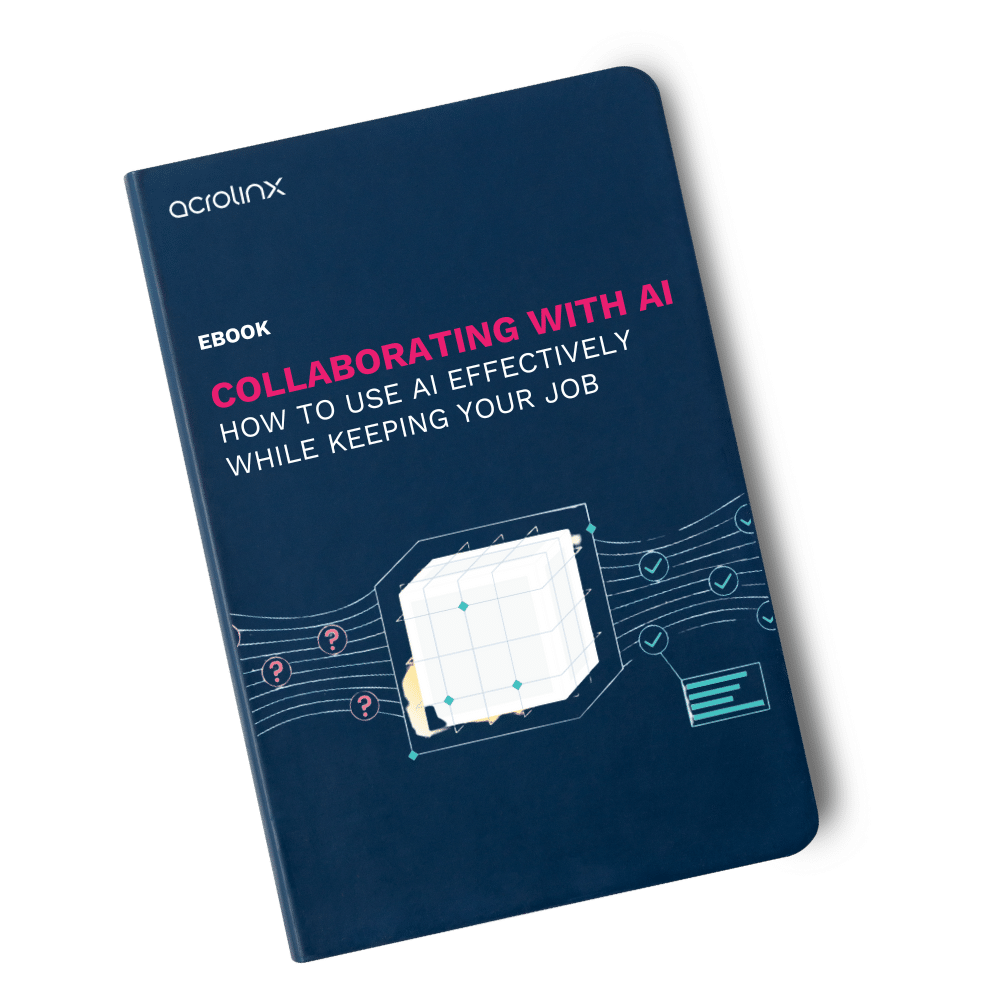How To Use Generative AI at Work To Improve Efficiency and Compliance

Is generative Artificial Intelligence your latest coworker?
It’s no secret that generative AI tools are taking workplaces by storm. With promises to increase efficiency and drive productivity gains, lots of companies are rushing to invest in them. And it’s easy to see why when these tools are helping people to draft emails, simplifying complex documents, or creating customer-ready support content — at speed.
But here’s the big question: How do you harness this exciting new tech in a way that’s not only efficient but also aligned with your company’s policies and regulatory requirements?
Before we dive into the “how,” let’s talk about the “why.” Generative AI is reshaping the workplace as we know it, but what’s driving the rise of generative AI technology in the workplace?
The rise of generative AI in the workplace
Generative AI has quickly become one of the most transformative technologies in the modern workplace. Its rise isn’t just hype — it’s a response to the growing need for speed, scalability, and precision in how businesses create, manage, and distribute content. From chatbots drafting customer responses to AI tools creating entire reports, the workplace is seeing a seismic shift in how work gets done.
But why now? The answer lies in a perfect combination of advancements in technology and evolving business demands. AI models, powered by billions of data points, have matured to the point where they can create human-like text, generate stunning visuals, and even assist with decision-making. At the same time, businesses are under more pressure than ever to do more with less — less time, fewer resources, and tighter budgets. Generative AI fills that gap, delivering efficiencies that weren’t possible before.
And the applications are almost endless. In the workplace, generative AI technology is:
- Accelerating content creation: Drafting blog posts, whitepapers, and even internal communications in a fraction of the time that result in productivity gains.
- Improving personalization: Tailoring customer communications to resonate with specific audiences that help you meet your sales targets.
- Streamlining workflows: Automating routine tasks like report generation or data analytics summaries that lead to cost savings.
- Supporting collaboration: Assisting teams with brainstorming, outlining ideas, and even providing creative inspiration that result in efficiency gains.
But let’s not forget the other half of the equation: compliance. While generative AI can help produce content faster, the rise of this technology also introduces new risks. Misaligned messaging, accidental biases, or inaccuracies pose major challenges in regulated industries like financial services, healthcare, and manufacturing.
That’s why successful adoption of generative AI in the workplace isn’t just about using the technology — it’s about using it responsibly. Companies need the right guardrails to make sure AI outputs aren’t only efficient but also accurate, consistent, and compliant with industry regulations.
Generative AI is no longer a “nice-to-have” — it’s rapidly becoming a necessity. But as organizations embrace these technological advancements, they also need strategies to make sure that AI helps, rather than hinders, their goals. The next step? Leveraging tools and systems that optimize AI outputs for quality and compliance. Let’s explore how.
How generative AI improves work efficiency
To truly unlock generative AI’s potential, you need the right tools and systems in place so that what it produces isn’t just fast — it’s high-quality, compliant, and aligned with your goals. Here’s how you can leverage technology to maximize efficiency without sacrificing accuracy.
Faster content creation
Generative AI makes creating content faster than ever, but speed alone doesn’t cut it. Tools like content governance platforms make sure that AI-generated outputs meet your brand standards, tone, and compliance requirements — right out of the gate.
By integrating AI technology with platforms that guide and check content as it’s created, your teams can produce polished, on-brand assets in a fraction of the time. It’s like having an editor, compliance officer, and style guide rolled into one.
Streamlined collaboration
Collaboration across teams is essential, but it can get messy — especially with large-scale content operations. AI-powered tools bring everyone onto the same page by aligning outputs with your company’s guidelines. Writers, editors, and compliance teams can work seamlessly, knowing that the content being produced adheres to tone, terminology, and legal requirements. Say goodbye to endless email threads and confusing edits, and hello to streamlined workflows that make teamwork effortless.
Increased productivity
With AI handling repetitive tasks like drafting and initial editing, your human workers can focus on the human skills that they do best: being creative, strategic, and innovative. Tools that optimize AI outputs make sure that the content meets standards from the start, reducing back-and-forth revisions. This doesn’t just save time; it frees up your team to tackle high-priority, critical thinking projects and generate more value for your business.
By combining generative AI with systems that prioritize quality and compliance, you create a powerhouse process that’s not only efficient but also trustworthy. The result? Content that works harder for your business — and your audience.
The compliance challenges of generative AI
All of the benefits of generative AI outlined above aren’t without potential compliance challenges. While generative AI can produce content at lightning speed, it doesn’t always guarantee accuracy, fairness, or consistency. For businesses, especially in regulated industries, that’s a challenge you can’t afford to ignore. Let’s explore the compliance hurdles of generative AI and how to overcome them.
Ensuring accuracy and avoiding bias
AI doesn’t know everything — it only knows what it’s been trained on. That means inaccurate or outdated data in the training set can lead to errors in your content. Worse yet, hidden biases in AI outputs can create unintended harm or alienate your audience. To stay on the right side of accuracy and fairness, use tools that align to your writing standards and flag potential biases in real time. Combine this with human oversight to validate sensitive or high-stakes content. Remember, accuracy builds trust, and trust is non-negotiable.
Meeting industry regulations
For industries like financial services, healthcare, or manufacturing, compliance isn’t just a suggestion — it’s the law. Generative AI can sometimes stray into gray areas, producing outputs that don’t align with regulatory requirements. That’s where systems like content governance platforms come in. These tools make sure your AI outputs are compliant by embedding regulatory checks and legal guidelines directly into your content workflows. Think of it as your compliance safety net, catching errors before they become liabilities.
Maintaining brand consistency
AI might generate text that’s grammatically correct, but is it on-brand? Without the right guardrails, you risk content that doesn’t reflect your voice, tone, or values — leaving your audience confused. Tools that enforce brand guidelines at the point of creation make sure every AI-generated word aligns with your messaging and resonates with your audience. This way, you maintain a consistent, recognizable voice, no matter how many writers (or AI models) are involved.
Standing out in a saturated world of AI written content
Let’s face it: Everyone is jumping on the generative AI bandwagon. That means there’s a flood of AI-written content out there, much of it generic or uninspired. To stand out, you need more than just fast content — you need content that’s meaningful, creative, and tailored to your audience. By pairing generative AI with tools that enhance tone and style, you rise above the noise and create content that truly connects.
Generative AI offers incredible potential, but with great power comes great responsibility. By tackling compliance challenges head-on, you can leverage AI to its fullest while staying accurate, aligned, and ahead of the competition.
Technical writers and compliance: Why’s it important?
Technical writers are the unsung heroes of compliance. They’re the ones making sure every product manual, policy document, and customer-facing guide isn’t only accurate but also meets regulatory standards.
Various regulations, such as the EU AI Act and FDA approval processes, as well as the Consumer Duty regulations in the UK, apply to highly regulated industries. Even small errors in documentation lead to major consequences, from legal fines to damaged reputations. But let’s be real — maintaining compliance across mountains of content is no easy feat. That’s why technical writers need the right tools to streamline their work, reduce manual checks, and stay on top of ever-evolving regulations.
Generative AI can speed up content creation, but without compliance safeguards, it leaves technical writers juggling quality, consistency, and accuracy. The result? More stress and less time to focus on the nuanced work that truly adds value.
How Acrolinx bridges the gap between AI efficiency and compliance
Enter Acrolinx: The ultimate sidekick for technical writers and content teams looking to marry the speed of AI with the rigor of compliance.
Acrolinx doesn’t just enhance generative AI outputs — it makes sure they’re aligned with your company’s standards, tone, and regulatory requirements. By providing real-time guidance on accuracy, style, and consistency, Acrolinx transforms AI-generated content into polished, compliant assets you can trust.
What’s more, Acrolinx scales seamlessly across your organization, making sure every writer (human or AI-assisted) produces on-brand, compliant content. It’s not just about keeping up with regulations — it’s about staying ahead. With Acrolinx, you can unleash the full potential of generative AI while protecting your brand’s integrity, boosting efficiency, and giving technical writers the support they need to thrive. Efficiency and compliance? It’s a win-win. See our product in action in our bi-weekly demo.
Are you ready to create more content faster?
Schedule a demo to see how content governance and AI guardrails will drastically improve content quality, compliance, and efficiency.

Charlotte Baxter-Read
Lead Marketing Manager at Acrolinx, bringing over three years of experience in content creation, strategic communications, and public relations. She holds a Master’s degree from the John F. Kennedy Institute, at Freie Universität Berlin, and a Bachelor's degree from Royal Holloway, University of London. Charlotte, along with the Acrolinx Marketing Team, won a Silver Stevie Award at the 18th Annual International Business Awards® for Marketing Department of the Year. She's a passionate reader, communicator, and avid traveler in her free time.





